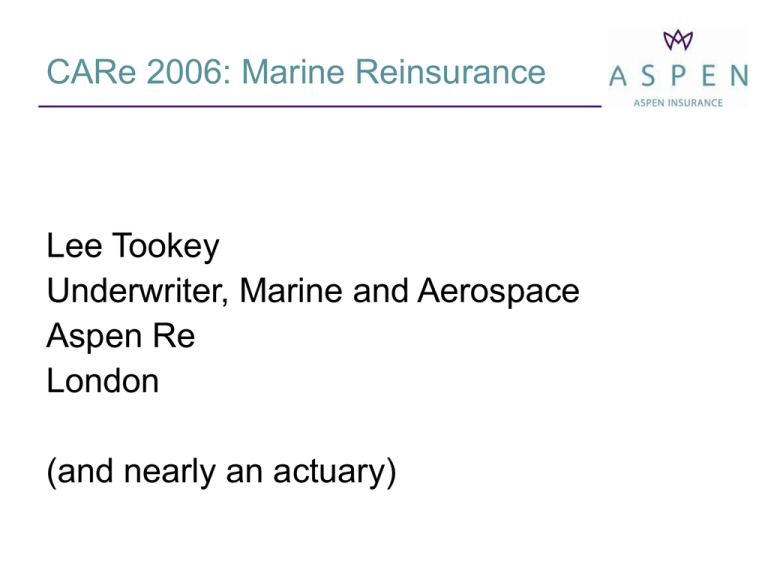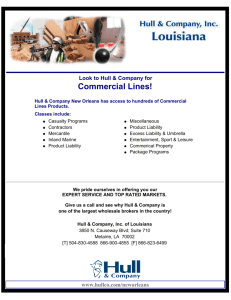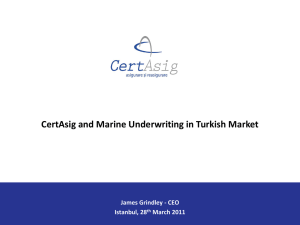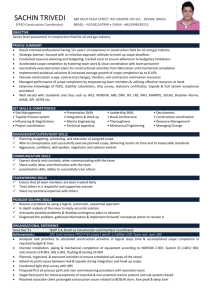Marine Reinsurance Rating
advertisement

CARe 2006: Marine Reinsurance Lee Tookey Underwriter, Marine and Aerospace Aspen Re London (and nearly an actuary) Marine Reinsurance: • • • • Introduction: review of the basics Objectives: what the actuary can do Some typical questions Some observations on specific classes – Hull – Cargo – Energy • Closing remarks Marine Reinsurance: Introduction • Significant Actuarial involvement for at least 15 years • Slow improvement in data – Always has been plenty of it but little consistency and difficult to model. • Little interest from commercial modelling companies – In house development and discussion papers Introduction (2) • • • • Proportional and Non-Proportional Facultative and Treaty Pure and Composite “Marine” Classes include – Hull – Cargo & Specie – Offshore Energy – Liability (Marine and Energy) Introduction (3): Non Proportional Treaty (pre 2005) • Risk and event common. • Attachment point of programme a function of maximum risk line. • Combined or “Whole Account” layers above specific class layers Introduction (4): Rating NonProportional Treaty • Usually experience and exposure rating – Experience from actual and “as-if” losses • Attritional risk losses • Headline risk losses • Catastrophes (natural and man made) – Exposure from • Risk profile and size of loss curve for risk losses • Market share and market loss return periods • Possibly stochastic models Introduction (5): Where is the experience? • Attachment point for excess of loss typically 10% of maximum line. • Usually few losses at this level • Money swap layers generally avoided • Low level backup layers in softer market • Frequency/severity approach would usually need to look at layer below programme An aside on attachment points • Of 68 marine programmes seen in 2006.. – 12 had a ROL>50% for first layer – Of these, 9 were domiciled in Americas or led by US reinsurers – All attached below 10% of maximum line • Possibly Lloyd’s influence – Underwriting capacity measured in terms of written premium Objectives • Using information we have, provide guidance to underwriters on – Pure premium – Volatility of result – Changes to exposure over time – Claims inflation – Accumulations Objectives (2) • Understanding the business from an insurance perspective • Understanding what information is collected and why • Understanding effects of changes in the market • Understanding the results of our analysis in light of the actual experience. Common Questions • Why is the experience rate so different to the exposure rate? • What has changed over the experience period and how can I quantify it? • How homogeneous is the exposure data and does that cause a problem? • What more is there to know and can the underwriter tell me? Marine Hull Excess of Loss Information • Typically loss experience given excess of 50% of attachment point last year. • Several years data usually available but what is the effect of… – Change in mix of vessel types – Change in lines size – Changes in policy conditions and coverage – Inflation Marine Hull Excess of Loss Information (2) • Risk Profiles – Gross or Net of reinsurance – By type of vessel ? – In force or risks written, what period • 9 month written profiles not uncommon – Premium, sum insured and count – Losses by band as well? Range of ocean going vessels • Very large container ships • Tankers • Bulk carriers • Passenger vessels • Car Carriers • Fishing vessels • Service boats Where is the value? • Container Vessel – Mostly in hull and engines, some machinery – Little else of value (apart from cargo) • Cruise ship – Hull and engines smaller percentage of value – Upper, accommodation decks high value So what if there is a fire? Underwriting approaches to book building vary • For larger vessels, percentage line, dollar line or both, smaller vessels 100% writing – “Normal” maximum line • Use of proportional treaty • Facultative reinsurance – Proportional or excess • Territorial considerations • Special acceptances All hull insurance is not the same • Standard coverage include – Hull and machinery (H&M) – Total Loss / Increased Value (IV) – Mortgagees Interests (MI) – Loss of Hire (LOH) – Collision Liability • But we rarely see the claims or the exposure broken down like this Hull Interest Example • H&M $200m • IV $50m • LOH $20m • Maximum partial loss – $220m (H&M + LOH) • Maximum total loss – $250m (H&M + IV) • In a risk profile, this may appear as three entries (200, 50, 20), one entry of $250m or one of $270m Hull and Machinery versus Total Loss • In some markets, TLO coverage is limited to certain percentage of total insured value • Premium rate significantly different – TLO may be 30% of all risk rate • Size of loss curves different for H&M and TLO – TLO pro rata Inflation • Very unpredictable – Salvage – Labour – Steel • Reflected to some extent by ship-owner revaluing vessel and we get rate on sum insured What we should aim to do • Price for the experience of the account – Adjusted for quantifiable changes in the account from re-underwriting or market changes – Allowing for events that haven’t happened • If the reinsured is getting premium for the risk, we should get our share A risk profile is so versatile…. • • • • Exposure rating – obviously Number of vessels and TSI Average rate by band Level and utilisation of maximum line size Adjusting Experience • Change in • % line, adjust losses and subject line size premium • Dollar line, harder to adjust. Need risk profiles to help • Change in • Ideally work from gross losses reinsurance and apply current RI strategy • Territory • Cat risk and usual perils of the sea Adjusting experience (2) • Usually use on level premium to adjust historic frequency / avg severity • Can use historic risk profiles – Index for frequency based on exposed vessels count to layer – Index average severity based on average exposed sum insured to layer Exposure rating • Current risk profiles gives indication of exposure • Assume size of loss curve appropriate • Underlying loss ratio assumption key. – But this may vary through risk profile • With all adjustments, often significant difference between experience and exposure What is available? • • • • Historic risk profiles usually are Commentary on line size Commentary on reinsurance Fleet mix • But no use asking 2 days before renewal A few cargo issues • • • • • • Policy limit or shipment How long is exposure on risk Where is most of trade What sort of commodity Accumulation risk Start and end of exposure Energy – the opportunity • After 2005 windstorm, full review • Great time to question – Every aspect of coverage under review • Significant change in data presentation – Sub limits in GOM for wind • Per policy not per platform • Does not effect risk rate • Increased modelling Closing • • • • • Do not stick to basic methods What else can we use data for Learn subject Engage underwriter and client Demonstrate use








